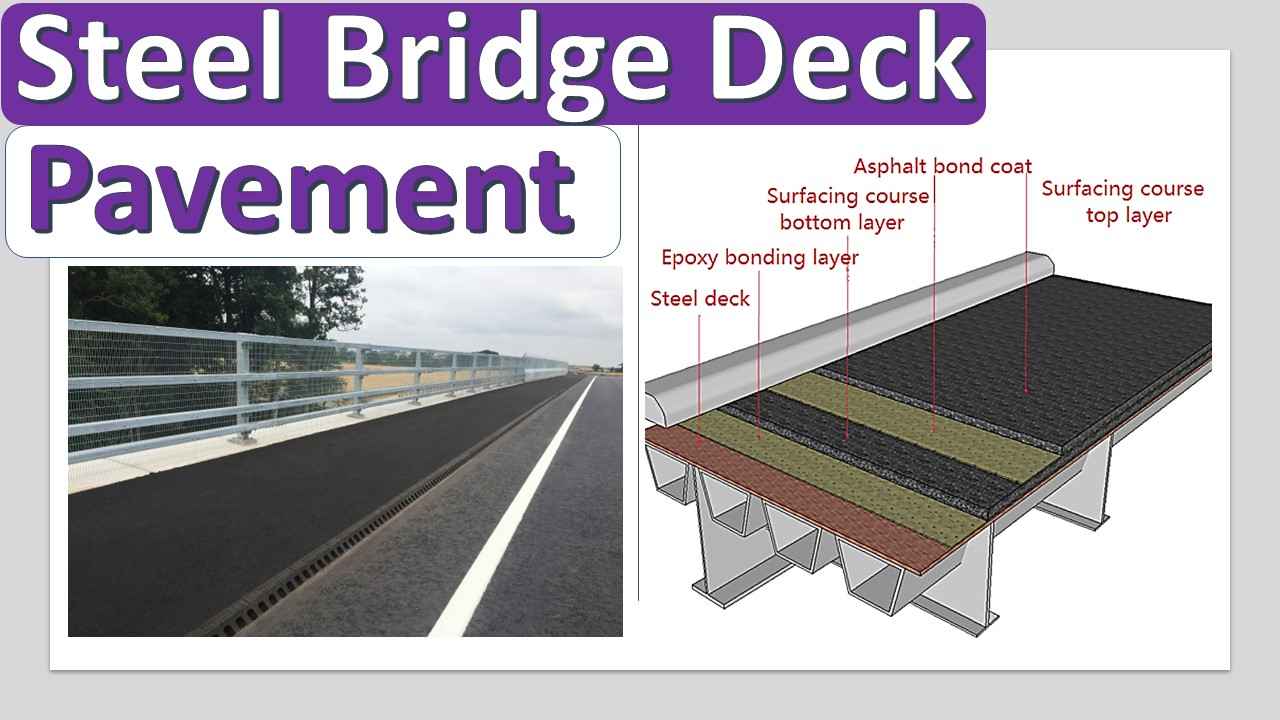Steel Bridge Deck Pavement
- By
- Pooja |
- November 25, 2022 |
- Civil Engineering, Highway Engineering, Bridge Engineering,

Table of Contents
Long-Life Steel Bridge Deck Pavement (LLSBDP)
Steel Bridge Deck Pavement
Protecting the steel bridge deck and allowing vehicles to use the bridge safely, steel bridge deck pavement (SBDP) is an essential paving layer on steel bridges. While steel bridges are designed to last between 100 and 120 years, the SBDP only has a 15-year lifespan. The SBDP will need to be replaced multiple times over the bridges' service lives. In reality, bridges functioned as the main arteries of the road system, carrying far heavier traffic volumes than regular roadways. Moreover, the stress states of the SBDP are more intricate for the unique support structures.
Due to the aforementioned issues, the SBDP has an expected average service life of fewer than 10 years. Here, there has been a lot of focus in recent years on finding ways to make the SBDP last longer in service. A standard asphalt pavement initially, SBDP has been in use for decades. Steel bridge spans and traffic loads have grown substantially as a result of advancements in transportation and bridge construction techniques.
Epoxy asphalt concrete, or EAC, is a modified asphalt concrete that is bound together using epoxy resin. EAC is a thermosetting substance, rather than a plastic-like conventional asphalt concrete. Thermosetting materials are cured using heat or chemical reactions, and once cured, they cannot be melted down or reformed.
Some of the EAC's unique qualities come from its thermosetting nature; for example, the material is extremely strong and resistant to fatigue. More than 60% of the long-span steel bridges spanning the Yangtze River in China were paved with EAC, and the SBDP on these bridges had much longer average service lives, according to the data collected.
Even with improvements, the useful life of EAC pavement remained short, and SBDP seldom lasted more than 15 years. More research into the SBDP's potential life-extension benefits is required.
Long-Life Steel Bridge Deck Pavement (LLSBDP)
Structural elements of durable asphalt can survive forever if the maximum individual load and environmental conditions for which the pavement was intended don't go overboard and sufficient and timely surface care is maintained.
The long-lasting pavement is predicated on reducing the potential for structural distress by reducing tensile strain at the AC layer's base and compressive strain at the subgrade's top. One common method is to improve the asphalt's base layer's modulus and stiffness. Here, under vehicle loads, the most significant pavement distresses are localised to the top surface layer.
It's possible that, over the course of the full design life, only superficial repairs will be necessary. It is clear from the picture that the SBDP was not paved like a typical roadway but rather on a steel bridge deck. SBDP typically had a thickness of 4-8 mm and was built in double-sided to achieve a more compact profile, a design choice motivated by a need to meet deadweight constraints.
It is envisioned that a long-life SBDP will have a long-life base course that will not experience any structural distress during the course of its service life, in accordance with the long-life pavement idea. Problems manifested only in the superficial layer, which could be restored with regular maintenance.“
The LLSBDP should have the following characteristics if it is to live up to the promise of long-lasting pavement:
- LLSBDP necessitates a minimum of two layers, the bottom of which acts as the base layer and the top as the wearing course. The LLSBDP requires a layer at the top that can be maintained and replaced as needed and a layer at the base that can withstand wear and tear for decades.
- surface pavement tensile stress should be minimised so that cracking doesn't occur. In order to stop cracking from propagating directly to the base layer once it has emerged, more cracking resistance is required at the bottom layer than at the top.
- The LLSBDP needs to have good stability and deformation compatibility with the steel deck like the regular SBDP does in order to give good serviceability.
The most common SBDP pavement structure is the "EAC + EAC" configuration. Nonetheless, it fell short of the benchmarks set by the LLSBDP. After examining LLSBDP and the "EAC + EAC" design in detail, the "EAC + SMA" layout was proposed. in which EAC is used for the lower base layer and SMA is used for the upper layer.
The cracking and fatigue resistances of EAC are significantly higher than those of SMA, meaning that once a fracture has formed, its progression will be halted at the interface between the two layers. In order to determine if this proposed LLSBDP architecture is practical, a combination of numerical modelling and experimental design was conducted.
Model
Saint-Venant accurately predicted that a specific load would have the greatest effect on the stress states of the pavement in a particular region. The steel bridge is represented by a model consisting of an orthotropic steel plate with four diaphragms and seven U-ribs.
In the model, an 8-note solid element represented the asphalt road, and a shell element represented the steel bridge deck. Stiff links connected the steel deck to the roadway, ensuring that both would flex together. The FE model used a total of 21,546 mesh components.
Evaluating the structural performance at temperature ranges, readings were made at 15, 20, and 60 degrees Celsius.
Load
The AASHTO-required rectangular load diagram was employed in the study. To replicate the effects of a 30% overload, the tyres were inflated to 0.91 MPa. Because of the diaphragm's symmetry, the load was applied to its top surface before being transferred along its length to the centre of the diaphragm between the two neighbouring diaphragms. Three different load circumstances were studied to determine the structure's operational state.
- Position I, the load from both wheels was distributed symmetrically over a U-shaped support structure.
- Position II, the centre of three U-ribs was subjected to the combined weight of the wheels.
- Position III the U-rib edge was loaded from above by a pair of wheels.
I hope the blog provides you with a sound understanding of steel bridge deck pavement (SBDP). Please feel free to like, share and comment.
Admin, gcelab.com
Please see our Pillar Post to know why we founded gcelab.com.
Read More:

Pooja
Founder at gcelab.com, Pooja is an Entrepreneur unlocking human potential. Working in the Principles of Lean Start-up, Pooja believes in Transparency and User Happiness the most. Pooja’s background in teaching gives her a sophisticated grasp on even the most tedious aspect of course building. She is passionate about people who believe that good is not enough.
Previous Post


